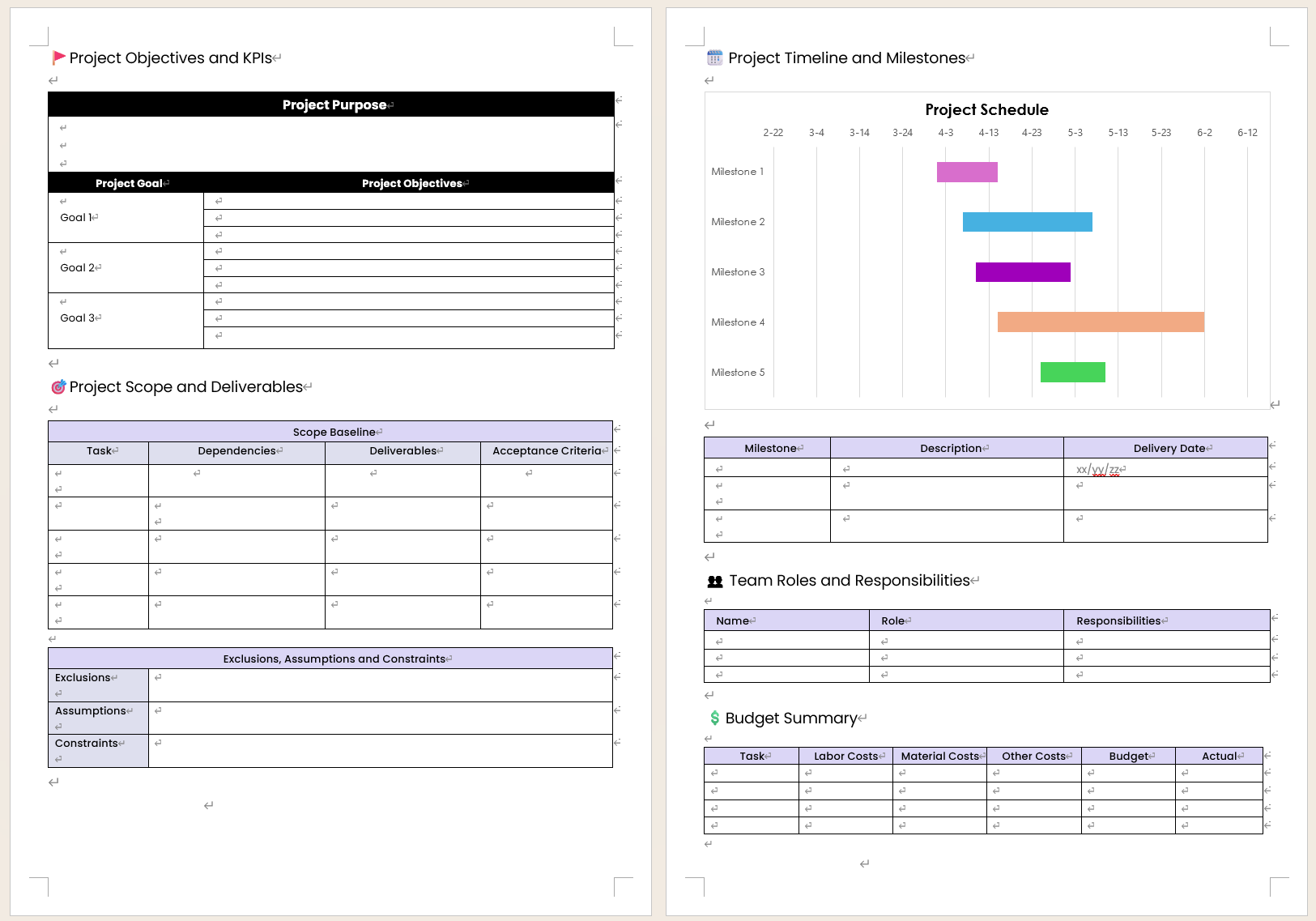Turning a great idea into reality requires more than enthusiasm; it needs a clear Implementation Plan. This guide offers an overview of the project implementation plan, defining its concepts, differentiating it from other documents, and highlighting its importance. It includes key components, a step-by-step creation process, a template structure, a practical example, and insights into effective tools like Morningmate for managing your project management implementation plan.
What Is an Implementation Plan?
An implementation plan is a clear document that describes the specific steps, resources, timeline, and responsibilities needed to successfully carry out a project or strategy. It serves as a practical guide, turning strategic goals into actionable tasks and making sure everyone involved knows their role in reaching the desired outcome. You can think of it as the connection between planning and action – a detailed roadmap for putting ideas into practice. While the terms planning and implementation are often related, the implementation plan specifically emphasizes the ‘how-to’ of executing the project.
Implementation Plan vs. Project Plan
While often confused, a Project Plan and an Implementation Plan serve different purposes. A Project Plan is a comprehensive document that covers the entire project lifecycle, including scope, budget, and timelines. In contrast, an Implementation Plan is a detailed section within the project plan that focuses on the execution phase. It specifies the actions, resources, and schedules needed to implement the project. While the project plan outlines what and why, the implementation plan explains how, who, and when. For smaller projects, these details may be combined, but complex initiatives often require a separate implementation plan.
Purpose of an Implementation Plan
An implementation plan provides clarity and direction during a project’s execution. Its key functions include guiding execution with a step-by-step approach, ensuring alignment among stakeholders, facilitating resource allocation, managing risks, tracking progress with milestones, and enhancing communication. Ultimately, it turns abstract goals into a concrete process, improving the chances of successful execution.
Why Is Implementation Planning Important?
Skipping detailed implementation planning can cause project delays, budget issues, and confusion, leading to failure. Effective planning and implementation are essential; they are interconnected. A solid plan helps teams anticipate challenges, clarify responsibilities, and avoid resource conflicts, ensuring a smoother execution process and maintaining project momentum.
Benefits of an Implementation Plan
Creating and following a detailed implementation plan has many benefits:
- Increased Clarity and Focus: Everyone knows the specific steps, their roles, and what is expected, which reduces confusion and keeps the team on track.
- Improved Communication: A clear communication plan ensures that team members and stakeholders receive timely updates and feedback.
- Better Resource Management: Planning for resource needs helps avoid shortages or overuse, making sure the right resources are available when needed.
- Enhanced Accountability: Clearly defined roles and responsibilities make it easier to track who is responsible for what and ensure tasks are completed.
- Proactive Risk Mitigation: Identifying potential risks early allows teams to create backup plans and address issues before they disrupt the project.
- Effective Progress Tracking: Setting clear milestones and deliverables provides benchmarks for monitoring progress and spotting potential delays early.
- Greater Stakeholder Confidence: A well-organized plan shows thoroughness and control, which builds trust with management, clients, and other stakeholders.
Higher Likelihood of Success: By offering structure, clarity, and foresight, a solid implementation plan greatly increases the chances of meeting project goals on time and within budget.
Key Components of an Implementation Plan
A comprehensive project implementation plan typically includes several key sections. While the specific implementation plan format can vary, these components are generally essential:
Goals and Objectives
This section clearly restates the specific, measurable, achievable, relevant, and time-bound (SMART) goals that the implementation aims to achieve. What does success look like? How will it be measured? This ensures alignment with the overall project strategy.
Scope Statement
Defines the boundaries of the implementation effort. What specific tasks, activities, and deliverables are included? Equally important, what is excluded? A clear scope statement helps prevent scope creep – the uncontrolled expansion of project requirements.
Deliverables and Milestones
Lists the tangible outputs (deliverables) that will be produced during the implementation (e.g., a configured software module, a trained user group, a launched webpage). It also identifies key milestones – significant checkpoints or achievements in the timeline that mark progress (e.g., completion of Phase 1, user acceptance testing sign-off).
Resource Planning
Details the resources required for successful implementation. This includes:
- Human Resources: Specific team members, roles, required skills, and time commitment.
- Budget: Financial resources allocated for tasks, tools, personnel, etc.
- Tools & Technology: Software, hardware, equipment, or facilities needed.
- Materials: Any physical supplies required.
Risk Management
Identifies potential risks or challenges that could impede implementation (e.g., technical issues, resource unavailability, budget cuts, resistance to change). For each risk, it should assess the likelihood and potential impact, and outline a mitigation strategy or contingency plan.
Roles and Responsibilities
Clearly defines who is responsible for each task and decision. Using a RACI chart (Responsible, Accountable, Consulted, Informed) can be helpful here. This ensures clear ownership and accountability throughout the process.
Timeline and Schedule
Provides a detailed schedule outlining when each task and milestone should start and finish. This is often visualized using a Gantt chart or timeline view, showing task dependencies and the critical path. It should be realistic and account for potential buffers.
Communication Plan
Outlines how, when, and with whom project information will be communicated. This includes defining communication channels (e.g., meetings, email updates, project management software notifications), frequency, and target audiences for different types of updates (e.g., team stand-ups, stakeholder progress reports).
How to Create an Implementation Plan (Step-by-Step)
Creating an effective implementation plan involves a structured approach. Here’s a step-by-step guide:
Step 1: Define Goals and Milestones
Start by clearly articulating the specific, measurable outcomes you aim to achieve through this implementation. What does success look like? Break down the overall goal into smaller, manageable milestones that represent significant progress points. Ensure these goals align with the broader strategic objectives.
Step 2: Conduct Research and Risk Analysis
Gather necessary information. This might involve understanding current processes, researching technology options, or analyzing stakeholder needs. Critically, identify potential risks. Brainstorm everything that could go wrong – technical hurdles, budget constraints, resource conflicts, external dependencies, lack of user adoption, etc. Assess the likelihood and impact of each risk.
Step 3: Assign Tasks and Responsibilities
Break down the implementation into specific, actionable tasks required to reach each milestone. For each task, clearly define who is responsible for completing it. Utilize a RACI matrix or similar tool to clarify roles (Responsible, Accountable, Consulted, Informed) for key activities and decisions, ensuring clear ownership.
Step 4: Allocate Resources
Based on the defined tasks, determine the necessary resources – personnel (specific skills, time commitment), budget, tools, technology, and materials. Create a resource allocation plan, ensuring resources are available when needed and potential conflicts are addressed. Secure necessary approvals for budget and resource assignments.
Step 5: Build the Implementation Timeline
Estimate the duration required for each task, considering dependencies (tasks that must be completed before others can start). Sequence the tasks logically and map them onto a timeline. Use tools like Gantt charts to visualize the schedule, identify the critical path (the sequence of tasks determining the project’s minimum duration), and set realistic deadlines for tasks and milestones. Include buffer time for potential delays.
Step 6: Communicate and Get Buy-in
Develop a communication plan outlining how progress, changes, and risks will be communicated to stakeholders. Present the draft implementation plan to key stakeholders (team, management, sponsors) to gather feedback, ensure alignment, and secure buy-in. Refine the plan based on feedback before finalizing and kicking off the implementation.
Implementation Plan Template (Free Download)

Implementation Plan Example
Let’s consider a concise implementation plan example for rolling out new Customer Relationship Management (CRM) software:
- Goal: Implement the new “ConnectCRM” software for the Sales team (20 users) by Q3 end, replacing the old system, aiming for a 90% user adoption rate within one month post-launch and a 15% increase in lead conversion tracking accuracy within Q4.
- Scope: Includes CRM configuration, data migration from the old system, user training, and initial support. Excludes integration with the Marketing Automation platform (Phase 2).
- Deliverables: Configured ConnectCRM instance, migrated customer data, trained sales team, user manuals.
- Milestones: Vendor Contract Signed (May 15), Configuration Complete (June 30), Data Migration Test Passed (July 15), User Training Complete (Aug 15), Go-Live (Sep 1), 90% Adoption Achieved (Oct 1).
- Tasks: (Detailed list in PM software) e.g., Define configuration requirements, Set up user accounts, Develop training materials, Conduct data cleansing, Perform migration test runs, Schedule training sessions, Execute final migration, Post-launch support.
- Roles: Project Manager (Sarah K.), IT Lead (David L.), Sales Lead (Maria G.), Vendor Contact (John D.), Training Lead (Sarah K.).
- Resources: Budget ($15k for software/vendor), IT Lead (50% allocation), Sales Lead (10% allocation), Training Room, Project Management Tool (Morningmate).
- Risks: Data migration errors (Mitigation: Thorough testing, data validation scripts), Low user adoption (Mitigation: Champion users, targeted training, ongoing support), Vendor delays (Mitigation: Regular check-ins, clear SLAs in contract).
- Communication: Weekly project team meetings via Zoom (recorded in Morningmate), Bi-weekly email updates to Sales Director, Use Morningmate project feed for daily updates and Q&A.
- Success Metrics: User login frequency, number of support tickets, lead conversion data accuracy in reports, user satisfaction survey results.
This example illustrates how the key components come together to form a coherent plan for execution.
Conclusion
A well-crafted implementation plan is not just administrative overhead; it’s a critical tool for navigating the complexities of project execution. By clearly defining goals, scope, tasks, resources, responsibilities, timelines, and risks, it provides the structure and clarity needed to turn strategy into successful reality. Whether using a dedicated project implementation plan template or building one from scratch, the process forces proactive thinking and alignment. Utilizing tools like Morningmate, Asana, or others discussed can further enhance management and communication during this vital phase. Don’t underestimate the power of planning how to implement – it’s the foundation upon which project success is built.



